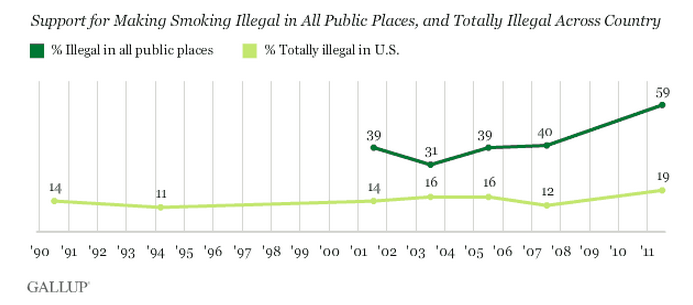Employers are highly attuned to the risks of tobacco use, particularly when it comes to the business and human toll.
Tobacco use is, of course, associated with higher health care costs for tobacco users. It’s also tied to lowered productivity and higher workers’ compensation, disability benefits and absenteeism.
For non-tobacco users, the exposure to second- and third-hand smoke generates grievances, lawsuits and a much higher incidence of health risks as well.
To curtail the use of tobacco, 55 percent of employers offer a tobacco cessation program and 21 percent assign a consequence to not participating in their program. More employers have adopted a no-hire tobacco rule, though it’s difficult to find numbers to determine how much of a growing trend this or another approach — banning tobacco use at work — truly is.
 Gallup polls show support for banning tobacco use at work and overall has grown over the years. Now, new evidence linking tobacco-free workplaces to a reduction in heart attacks and hospitalizations may have more employers considering the move.
Gallup polls show support for banning tobacco use at work and overall has grown over the years. Now, new evidence linking tobacco-free workplaces to a reduction in heart attacks and hospitalizations may have more employers considering the move.
The Los Angeles Times reports on a Mayo Clinic study that tracked the rate of heart attacks following the institution of a tobacco ban:
Banning indoor tobacco use from restaurants and workplaces drove down the rate of heart attacks by one-third in Olmsted County and reduced sudden cardiac death rates there by 17%. Interestingly, the study found that outlawing tobacco smoke in restaurants alone was not enough to have any discernible effect: It was not until phase 2 of the Olmsted County ordnance was implemented—forbidding cigarette smoking inside of bars and workplaces as well—that the full influence of the measure became clear.”
Another study reported by NPR found workplace and other indoor smoking bans greatly reduced hospitalizations:
Banning indoor smoking also swiftly lowers the number of people hospitalized for smoke-related health problems, the second study found. Researchers at the University of California, San Francisco combed through 45 studies covering 33 smoke-free laws in the United States and other countries. They found that total indoor smoking bans were associated with a 15 percent decrease in hospitalization for heart attacks; a 16 percent decrease for stroke; and a 24 percent decrease in hospitalizations for lung diseases like asthma and chronic obstructive pulmonary disease.
The stricter the law, the fewer people landed in the hospital.”
In a separate write-up of these studies by USA Today, the researchers also cited a lower incidence of overall tobacco use:
Fewer people smoked at home, as well. The percentage of smoke-free homes in the state grew from 64.5% in 1999 to 87.2% in 2010, a period in which state and federal taxes also rose significantly, the Mayo study shows.”
Our physical environment guides us to behaviors, healthy or unhealthy. We’re discovering that we can use design to lead us to better food choices, more activity and, of course, collaboration. It shouldn’t surprise us that design can also lead us to give up tobacco.
This was originally published on Fran Melmed’s free-range communication blog.
